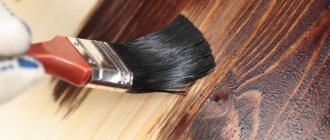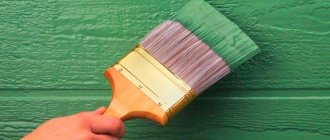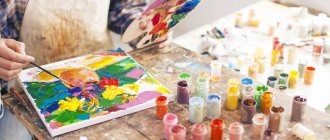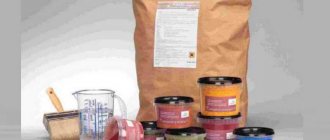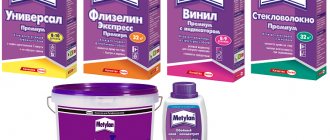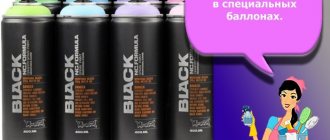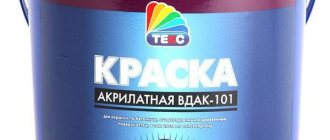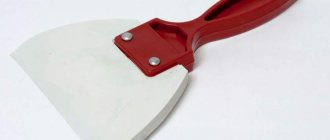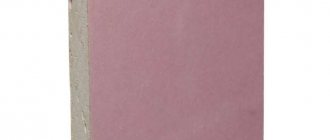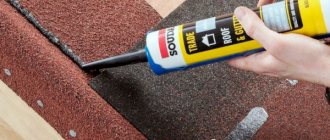Characteristics of dyes for plastic surfaces
Aerosol sprays for painting plastic are popular with most decorators due to their ease of use. The following types of enamel are available in cans:
- Polymer, combining the functions of a primer and a dye. Polymer paints for plastic are characterized by high adhesion and do not require a preliminary primer layer.
- Resistant to damage. These are especially durable compounds, in the manufacture of which polyurethane additives and acrylates are used. This type of enamels is used for surfaces subject to great mechanical stress.
- Structural. When dry, such dyes give a beautiful, slightly rough surface, hiding small flaws that have arisen on the plastic. The use of structural paints allows you to create original decor.
- Soft touch. A coloring composition that allows you to obtain a surface that is velvety to the touch. Objects decorated with this type of enamel create a feeling of softness and comfort.
- Monad, designed for PVC plastic. Adheres well to the base and is UV resistant.
Such a wide range of painting compositions allows you to select an aerosol preparation suitable for a specific type of plastic.
A little history
Aerosol paint was born in the 18th century thanks to the observation skills of French confectioners. They noticed that carbonated drinks were being pushed out of the container without assistance.
This fact was brought to the attention of a scientist from Norway, who was searching for a way to apply wax to skis, which was simpler than traditional methods. He managed to invent the prototype of the aerosol can, which is currently known.
American specialists have perfected this product. It was filled with chemicals that were used to kill harmful insects. Aerosol paint in cans appeared on the chemical market in the mid-20th century. Since then, it has been used in various fields of human activity.
Advantages and disadvantages of sprays
Aerosol enamels are in great demand, because they have the following advantages:
- Does not require additional painting tools.
- Convenient and easy to use (even a beginner can handle spraying the coloring spray).
- They give a beautiful, even layer of spraying.
- Storage does not require special conditions. Even the remains of unused spray paint are protected from drying out and can be stored for a long time.
- Suitable for both creating decorative designs and for uniform coloring.
- They have a large palette of colors and allow you to imitate the structure of various materials (wood, metal).
- The bright color of the paint is not subject to fading and retains its newness for a long time.
- Economical consumption. One can of paint lasts a long time.
But, like any product, aerosol dyes for plastic have their drawbacks. These include:
- Lack of tinting options. But this drawback is conditional, because the color range of coloring sprays for plastic is very wide, and you can easily select the desired shade. If you need a complex color, the painters will create it, and refilling the can with paint - this service is available in most stores selling aerosol dyes.
- If the technician is inexperienced, the paint may form streaks on smooth plastic. For beginners, before starting to paint the product, it is recommended to practice on an unnecessary piece of plastic that has a similar structure.
- Wide spray area. If you plan to paint only a small area, then it is necessary to cover the areas not to be painted with masking tape.
- The thickness of the enamel is not adjustable; you have to work with the consistency of the solution that is filled into the can.
- When painting large areas, it is necessary to purchase a large number of cylinders at once.
- When working outdoors, you must wait for warm, windless weather.
Despite the minor disadvantages of aerosol compositions, craftsmen very often use them to decorate plastic surfaces.
Coloring plastic at home
You can handle painting plastic materials yourself; this will greatly save your budget. Turning to professionals is very expensive. To carry out the work at home yourself, you will need to take care of your own safety by preparing protective equipment, also prepare all the necessary tools (listed above), and perform all stages of the work. They will be discussed in detail further.
You can handle painting plastic materials yourself; this will greatly save your budget.
Painting methods
The paint coating is available either in cans or in aerosols. Which option to choose depends on the size of the product and the experience of the person who will carry out the painting work.
- Spray cans are more appropriate for a small painting object; they are not difficult to work with, but before you start, you should try it out by spraying a little paint on an unnecessary surface, this will help you understand how best to spray to get the desired result. In general, the aerosol method will give a good, even coating. This method does not allow you to mix tones, and thus it will not be possible to apply clear color boundaries.
- The jar is larger in volume than the can, but storage in it is only possible for a short time. For this reason, it is often used for large volumes of work. It should also be taken into account that working with a brush is much more difficult and requires skill. Otherwise, unsightly traces of bristles and stains may remain on the product, the coating will be uneven and aesthetically look untidy.
Using a spray gun can make the process easier; a roller is rarely used. For a beginner, the spray can method would be more suitable.
Preparing plastic for painting
As mentioned earlier, you should carefully prepare the product before starting work in order to get an excellent result. This stage includes the following steps:
- To get rid of the previous cladding, you can use sandpaper, solvent, or a hair dryer.
- Get rid of contaminants.
- The product must be degreased using a solvent.
- Treat the product with antistatic agent.
- If required, use putty.
- To ensure good adhesion, the surface is treated with sandpaper no more than No. 180; after completing this stage, the object is cleaned and dried again.
- Degreasing is carried out again.
- Carry out priming work if required.
- Grind and clean again.
The product must be degreased using a solvent.
Plastic coloring technology
Having chosen the type of coloring agent, it is worth understanding the working method. The article will discuss two technologies: painting with a brush and applying with an aerosol.
They work with the brush, making wide, straight strokes, initially moving the brush softly, then pressing harder, so the coating will become thinner, and the finishing touch is also done softly to level it out. If everything is done correctly, then a one-time brush job is enough.
General recommendations:
- You don’t need to dip the whole brush, just the tip is enough;
- You should strive to make the layer as thin as possible by pressing on the bristles;
- Maintain the slope of the working position of the hand.
They work with a brush, making wide, straight strokes, initially moving the brush gently, then pressing harder.
The spray can process:
- Place the product on a flat surface, for example on a chair, mark the part to be painted with paper tape, cover nearby objects (with film, newspaper, paper);
- You must first shake the aerosol;
- There should be 20-30 centimeters left to the object;
- Spray the paint smoothly in one layer, holding the can straight;
- For complete coloring it is worth doing two or three layers;
- Between applying layers, wait the time indicated on the packaging until dry;
- After completing the work, remove the tape immediately.
After waiting for it to dry, you can coat the item with varnish to increase wear resistance. Acting in the same way as when painting.
Spray the paint smoothly in one layer, holding the can straight.
Paint for plastic is a great option to refresh old items and give them new life. The presence of a wide variety of colors allows you to come up with various solutions for decoration. Before painting the plastic, use all your imagination, take on board the tools necessary for this process, and as a result, you can perfectly decorate your home yourself.
Tools needed for decoration
Despite the fact that painting with aerosols is simple and convenient and this method allows you to do without painting tools, you still need to prepare the following:
- fine-grained “skin”;
- water, detergent and soft cloth;
- covering material;
- degreaser (white spirit or other alcohol-containing solvent);
- primer (for some types of plastic surfaces);
- gloves, safety glasses and a respirator.
If the item to be painted is heavily scratched or has dents, it is additionally recommended to stock up on plastic putty.
Preparing for painting
For novice craftsmen, the process of working with an aerosol sprayer may seem complicated, but strict adherence to all stages will help to achieve success. Before you start painting, you need to prepare the surface of the product. To do this, do the following:
- Cleaning the product. In order for the final result to please you with beauty and durability, it is necessary to thoroughly rinse the surface with water and detergent; deep stains can be washed with a stiff brush. Don't be afraid to scratch the surface of the plastic: further grinding and applying enamel will make the surface smooth. But if the dirt is not completely removed, the paint will lie unevenly and will soon begin to bubble or crack. After the item has been washed, it must be rinsed with clean water to remove any residual detergent and dried thoroughly.
- Grinding. All small irregularities are smoothed out using fine-grained sandpaper. If the product has large cracks or dents, it is recommended to smooth them out using plastic putty before sanding.
- Degreasing. Various grease stains impair the adhesion of the enamel to the base, so they must be removed using degreasers. Alcohol-containing degreasers do not need to be washed off, but other solvents must be removed by rinsing the product with clean water and drying.
- Padding. This step is not required for all types of plastic. How to determine the need for priming? Place the plastic item in a large container of water: if it sinks, you can skip the process of applying primer. If there is any doubt about the need for primer, it is better to apply primer. Additional priming will promote stronger adhesion of the enamel to the base.
After the primer has dried, you can begin applying paint.
Paint selection
Knowledge of the plastic that is to be painted will help you choose the right paint, as well as the right technology for applying it.
- Cases for most household appliances, computer equipment, etc. made from ABS plastic. It is a technical thermoplastic, impact-resistant resin. It is based on a copolymer of acrylonitrile with butadiene and styrene.
- PVC plastic is more familiar as a building material.
Both types require a primer to be applied before painting, which will make the adhesion of the paint to the surface stronger and better.
How to properly use a dye canister
When sprayed, paints in aerosol cans form a fine suspension in the air, which settles not only on the object being painted, but on other surfaces. In addition, small paint particles may enter the eyes or respiratory tract. To avoid this, you need to do the following:
- Cover all areas not intended for painting with covering material (for this purpose you can use plastic film, cardboard, old fabric, etc.). Cover narrow areas that do not need to be painted with masking tape.
- Wear safety glasses, a respirator and gloves while working.
After such preparation you can paint. This should be done as follows:
- If the item to be painted is small in size, then to improve the quality of painting it is better to place it on a horizontal surface covered with covering material.
- Shake the can of enamel for 30-40 seconds to mix the dye.
- Remove the cap and release the first test stream of paint onto an unnecessary base, for example, a piece of cardboard. This is necessary because air may accumulate in the sprayer, and the first pieces of enamel will fly out in uneven “spits”. Once the dye comes out of the container evenly, you can begin to paint the plastic.
- When spraying, move your hand with the aerosol in smooth movements, without stopping in one place. Spraying one area for a long time leads to the formation of enamel streaks. Keep the aerosol at a distance of 20-30 cm from the surface to be painted.
- After painting, let the first layer dry (about 20-30 minutes) and paint again. If necessary, apply third and subsequent layers.
Despite the fact that coloring solutions for plastic dry quickly, it is recommended to start using the product only after 24 hours. During this time, the final polymerization of the coloring agent will occur, and the decorative layer will become durable.
Coating options
Chrome paint is made with various effects. Compositions with reflection (white mirror shine) resemble polished stainless metal, molten silver. Pigment dyes are not added to this mixture; the base is made transparent.
Compositions with reflection (white mirror shine) resemble polished stainless metal, molten silver.
Yellowish, yellow-orange metallic shades are created through the use of ground copper alloys: brass, bronze. The effect is visible only after the base has dried. Coloring pigments are introduced into high-temperature coatings to achieve the desired shade.
Yellowish, yellow-orange metallic shades are created through the use of ground copper alloys: brass, bronze.
Matte paint creates the effect of brushed metal, on which small scratches are invisible.
Classic chrome finish
Mirror compounds are created for the restoration of chrome parts, they return them to their former shine and attractiveness. Spray cans are used to decorate photo frames and exotic bottles. Aerosols are produced with pigment dyes.
Powder can paint is used in auto repair shops and creates a silver tint with a mirror finish. Fine aluminum powder is diluted on a resin or acrylic base, which, after the paint layer has dried, refracts and reflects light rays.
Mirror compounds are created for the restoration of chrome parts, they return them to their former shine and attractiveness.
Black chrome
There is nitro paint in cans and cans designed for painting objects black. This is an alternative to Kuzbasslak. Two-component black chrome can paint produces a wear-resistant film. Nitro paint in cans has to be renewed more often.
Aerosol black chrome dries fastest.
Colored chrome plating
The introduction of a certain amount of pigment into the varnish base does not affect the quality of the film formed; the shine and metallic effect are preserved. Manufacturers produce annual colored coatings and transparent ones that can be tinted. You can achieve the desired shade during car body repairs.
The pigments in liquid chrome should be translucent, refracting light rather than absorbing light of a specific wavelength. There are dyes with a scattering effect; they are added to matte chrome, used for household items and the manufacture of souvenirs.
You can achieve the desired shade during car body repairs.
Useful Tricks
To ensure high-quality painting, professional craftsmen recommend:
- Purchase cylinders with replaceable tips that make it possible to adjust the width of the dye jet.
- Apply a new layer only after the previous one has dried.
- If the product is intended to be used frequently, it is recommended to apply more layers.
Following these little tricks and strictly following all stages of painting guarantees an excellent result.
It is very convenient to use aerosols for painting plastic products. If you choose the type of dye in accordance with the purpose of the item and the type of plastic, then the decorated item will delight you with its beautiful appearance for a long time.
